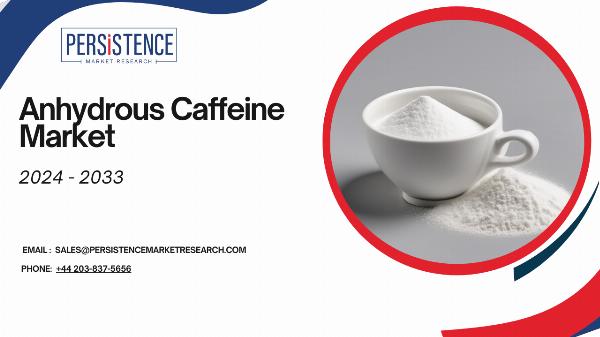Pamabrom vs Caffeine Anhydrous: A Comparative Analysis for Health Products

Strong 8k brings an ultra-HD IPTV experience to your living room and your pocket.
In the health and wellness industry, various active ingredients are used to enhance the effectiveness of supplements, medications, and other health products. Two such popular ingredients are pamabrom and caffeine anhydrous, each of which is used for different purposes yet shares some overlapping benefits, particularly in promoting increased energy, alertness, and improved physical performance. Despite these similarities, they differ significantly in their mechanisms of action and applications. This comparative analysis explores the key differences between pamabrom and caffeine anhydrous and their respective roles in the health product market.
For More Industry Insight: https://www.persistencemarketresearch.com/market-research/anhydrous-caffeine-market.asp
Understanding Pamabrom
Pamabrom is a mild diuretic commonly used to relieve bloating and water retention, particularly in women experiencing premenstrual syndrome (PMS). It is often included in over-the-counter medications designed to reduce discomfort associated with bloating, headaches, and menstrual cramps. By promoting gentle water loss from the body through increased urination, pamabrom helps alleviate the feeling of heaviness or bloating, making it a popular choice for women looking to manage PMS symptoms.
Pamabrom’s diuretic effects are typically mild, allowing it to provide symptom relief without causing significant dehydration. In combination with pain relievers like acetaminophen or ibuprofen, pamabrom is frequently found in menstrual relief products, where it addresses bloating while the pain reliever targets cramps or headaches.
Understanding Caffeine Anhydrous
Caffeine anhydrous is a concentrated, powdered form of caffeine that has had all its water content removed. Known for its potency, caffeine anhydrous is widely used in energy supplements, pre-workout formulas, and fat burners due to its ability to rapidly increase energy levels, improve focus, and enhance physical performance. It stimulates the central nervous system by blocking adenosine, a neurotransmitter that promotes relaxation and sleep, thereby increasing alertness and reducing fatigue.
Unlike regular caffeine found in beverages like coffee and tea, caffeine anhydrous is more concentrated and can be consumed in smaller quantities to achieve the same effects. This makes it a preferred ingredient in products where consumers seek quick and potent results, such as pre-workout supplements, energy pills, and cognitive enhancers.
Key Differences Between Pamabrom and Caffeine Anhydrous
While both pamabrom and caffeine anhydrous are active ingredients in health products, they serve very different functions. Below are the key distinctions:
Primary Function:
Pamabrom: As a diuretic, pamabrom’s main purpose is to reduce water retention and bloating. It works by promoting mild water loss through increased urination, which helps relieve the sensation of heaviness or bloating, especially during PMS.
Caffeine Anhydrous: Caffeine anhydrous primarily functions as a stimulant, increasing energy levels, improving focus, and enhancing physical endurance. It is often used to combat fatigue, increase alertness, and improve athletic performance.
Mechanism of Action:
Pamabrom: Pamabrom acts by stimulating the kidneys to expel more water from the body, which reduces bloating and helps manage water retention.
Caffeine Anhydrous: Caffeine anhydrous works by blocking adenosine receptors in the brain, which in turn prevents the onset of drowsiness and promotes alertness. It also stimulates the release of adrenaline, increasing energy levels and physical performance.
Application in Health Products:
Pamabrom: Pamabrom is commonly found in over-the-counter medications aimed at managing premenstrual symptoms such as bloating, water retention, and minor discomfort. It is often combined with pain relievers to address a broader range of PMS-related issues.
Caffeine Anhydrous: Caffeine anhydrous is widely used in dietary supplements, energy products, and fat burners. Its primary role is to provide a quick boost in energy and mental focus, making it a popular ingredient in pre-workout supplements, fat-burning supplements, and cognitive enhancers.
Consumer Base:
Pamabrom: Pamabrom is primarily targeted at women who experience bloating and water retention due to PMS, although it may also be used for other mild water retention issues.
Caffeine Anhydrous: Caffeine anhydrous appeals to a broader consumer base, including athletes, fitness enthusiasts, busy professionals, and anyone seeking enhanced physical and mental performance.
Side Effects:
Pamabrom: The most common side effect of pamabrom is frequent urination due to its diuretic effects. In some cases, overuse can lead to dehydration if proper hydration isn’t maintained.
Caffeine Anhydrous: Caffeine anhydrous can cause several side effects if consumed in large amounts, including jitters, increased heart rate, anxiety, and insomnia. Overuse of caffeine-based products can also lead to caffeine dependence and withdrawal symptoms.
The Role of Pamabrom in Health Products
Pamabrom’s primary role in health products is to manage symptoms of water retention and bloating, making it especially useful in products targeting PMS relief. In combination with pain relievers, pamabrom helps reduce bloating while also providing relief from menstrual cramps, headaches, and back pain.
While pamabrom is primarily used for menstrual-related symptoms, it can also be employed in other mild diuretic products for managing occasional water retention. Its gentle action makes it a suitable option for individuals seeking a non-invasive way to alleviate bloating without the risk of severe dehydration.
The Role of Caffeine Anhydrous in Health Products
Caffeine anhydrous plays a significant role in the energy supplement market. Its ability to provide quick, potent energy boosts makes it a staple ingredient in pre-workout products and energy pills. Athletes and fitness enthusiasts rely on caffeine anhydrous to improve physical performance, boost stamina, and increase focus during workouts.
In addition to its role in sports nutrition, caffeine anhydrous is also commonly used in fat-burning supplements due to its ability to increase metabolism and promote calorie burning. Its thermogenic effects make it a valuable ingredient in weight loss products.
Furthermore, caffeine anhydrous is a key component in cognitive enhancers or nootropics, where it helps improve mental clarity, focus, and reaction time. Its stimulating effects on the central nervous system make it ideal for individuals seeking enhanced cognitive performance during mentally demanding tasks.
Note: IndiBlogHub features both user-submitted and editorial content. We do not verify third-party contributions. Read our Disclaimer and Privacy Policyfor details.


